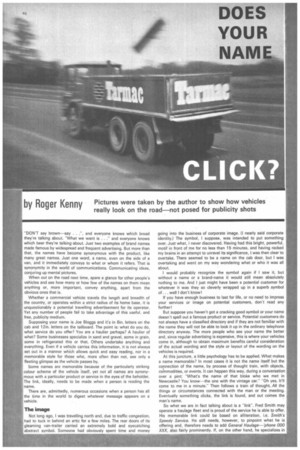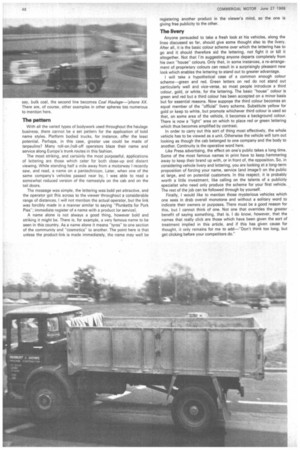"DON'T say brown—say . ., and everyone knows which bread
Page 48

Page 50

If you've noticed an error in this article please click here to report it so we can fix it.
they're talking about. -What we want is . ." and everyone knows which beer they're talking-about. Just two examples of brand names made famous by widespread and freqUent advertising. But more than that, the names have become synonymous with the product, like many great names. Just one word, a name, even on the side of a van, and it immediately conveys to what or whom it refers. That is synonymity in the world of communications. Communicating ideas, conjuring up mental pictures.
When out on the road next time, spare a glance for other people's vehicles and see how many or how few of the names on them mean anything or, more important, convey anything, apart from the obvious ones that is.
Whether a commercial vehicle travels the length arid breadth of the country, or operates within a strict radius of its home base, it is unquestionably a potential travelling advertisement for its operator. Yet any number of people fail to take advantage of this useful, and free, publicity medium.
Supposing your name is Joe Bloggs and it's in ein. letters on the cab and 12in. letters on the tailboard. The point is: what do you do, what service do you offer? You are a haulier perhaps? A haulier of what? Some businesses specialize in sand and gravel, some in grain, some in refrigerated this or that. Others undertake anything and everything. Even if a vehicle carries this information, it is not always Set out in a manner which allows quick and easy reading, nor in a memorable style for those who, more often than not, see only a fleeting glimpse as the vehicle passes by.
Some names are memorable because of the particularly striking colour scheme of the vehicle itself, yet not all names are synonymous with a particular product or service in the eyes of the beholder. The link, ideally, needs to be made when a person is reading the name.
There are, admittedly, numerous occasions when a person has all the time in the world to digest whatever message appears on a vehicle.
The image
Not long ago, I was travelling north arid, due to traffic congestion, had to tuck in behind an artic for a few miles. The rear doors of its gleaming van-trailer carried an extremely bold and eyecatching abstract symbol. Someone had obviously spent time and money going into the business of corporate image. (I nearly said corporate identity.) The symbol, I suppose, was intended to put something over. Just what, I never discovered. Having had this bright, powerful, motif in front of me for no less than 1 5 minutes, and having racked my brains in an attempt to unravel its significance, I was then clear to overtake. There seemed to be a name on the cab door, but I was overtaking and went on my way wondering what or who it was all about.
I would probably recognize the symbol again if I saw it, but without a name or a brand-name it would still mean absolutely nothing to me. And I just might have been a potential customer for whatever it was they so cleverly wrapped up in a superb symbol of ... well I don't know!
If you have enough business to last for life, or no need to impress your services or image on potential customers, don't read an further!
But suppose you haven't got a cracking good symbol or your name doesn't spell out a famous product or service. Potential customers do not always have a classified directory and if they are not familiar with the name they will not be able to look it up in the ordinary telephone directory anyway. The more people who see your name the better and, since regular advertising is expensive, this is where your vehicles come in, although to obtain maximum benefits careful consideration of the actual wording and the style or layout of the wording on the vehicles is required.
At this juncture, a little psychology has to be applied. What makes a name memorable? In most cases it is not the name itself but the connection of the name, by process of thought train, with objects, commodities, or events. It can happen this way, during a conversation over a pint; "What's the name of that bloke who we met in Newcastle? You know the one with the vintage car." "Oh yes. It'll come to me in a minute." Then follows a train of thought. All the things or circumstances connected with the man or the meeting. Eventually something clicks, the link is found, and out comes the man's name.
So what we are in fact talking about is a "link". Fred Smith may operate a haulage fleet and is proud of the service he is able to offer. His memorable link could be based on alliteration, i.e. Smith's Speedy Service. He still needs, however, to pinpoint what he is offering and, therefore needs to add General Haulage—'phone 000 XXX, also fairly prominently. If, on the other hand, he specializes in
The pattern
With all the varied types of bodywork used throughout the haulage business, there cannot be a set pattern for the application of bold name styles. Platform bodied trucks, for instance, offer the least potential. Perhaps, in this case, greater use could be made of tarpaulins? Many roll-on /roll-off operators blaze their name and service along Europe's trunk routes in this fashion.
The most striking, and certainly the most purposeful, applications of lettering are those which cater for both close-up and distant viewing. While standing half a mile away from a motorway I recently saw, and read, a name on a pantechnicon. Later, when one of the same company's vehicles passed near by, I was able to read a somewhat (educed version of the namestyle on the cab and on the tail doors.
The message was simple, the lettering was bold yet attractive, and the operator got this across to the viewer throughout a considerable range of distances. I will not mention the actual operator, but the link was forcibly made in a manner similar to saying "Plunketts for Pork Pies"; immediate register of a name with a product (or service).
A name alone is not always a good thing, however bold and striking it might be. There is, for example, a very famous name to be seen in this country. As a name alone it means "tyres" to one section of the community and "cosmetics" to another. The point here is that unless the product-link is made immediately, the name may well be registering another product in the viewer's mind, so the one is giving free publicity to the other.
The livery
Anyone persuaded to take a fresh look at his vehicles, along the lines discussed so far, should give some thought also to the livery. After all, it is the basic colour scheme over which the lettering has to go and it should therefore aid the lettering, not fight it or kill it altogether. Not that I'm suggesting anyone departs completely from his own "house" colours. Only that, in some instances, a re-arrangement of proprietary colours can result in a surprisingly pleasant new look which enables the lettering to stand out to greater advantage.
I will take a hypothetical case of a common enough colour scheme—green and red. Green letters on red do not stand out particularly well and vice-versa, so most people introduce a third colour, gold, or white, for the lettering. The basic "house" colour is green and red but a third colour has been accepted on a minor basis but for essential reasons. Now suppose the third colour becomes an equal member of the "official" livery scheme. Substitute yellow for gold or keep to white, but promote whichever third colour is used so that, on some area of the vehicle, it becomes a background colour. There is now a "light" area on which to place red or green lettering which thus becomes amplified by contrast.
In order to carry out this sort of thing most effectively, the whole vehicle has to be viewed as a unit. Otherwise the vehicle will turn out looking as though the cab belonged to one company and the body to another. Continuity is the operative word here.
Like Press advertising, the effect on one's public takes a long time. Some of the most famous names in print have to keep hammering away to keep their brand up with, or in front of, the opposition. So, in considering vehicle livery and lettering, you are looking at a long-term proposition of forcing your name, service (and image!) on the public at large, and on potential customers. In this respect, it is probably worth a little investment, like calling on the talents of a publicity specialist who need only produce the scheme for your first vehicle. The rest of the job can be followed through by yourself.
Finally, I would like to mention those mysterious vehicles which one sees in drab overall monotone and without a solitary word to indicate their owners or purposes. There must be a good reason for this, but I cannot think of one. Not one that overrides the greater benefit of saying something, that is. I do know, however, that the names that really click are those which have been given the sort of treatment implied in this article, and if this has given cause for thought, it only remains for me to add—"Don't think too long, but get clicking before your competitors do."


















































































































